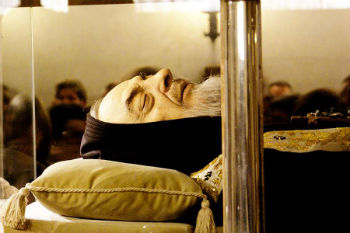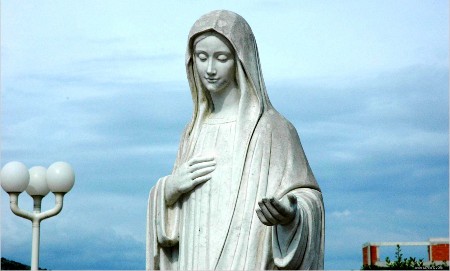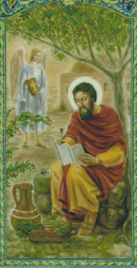Hroswitha
FREE Catholic Classes
A celebrated nun -poetess of the tenth century, whose name has been given in various forms, ROSWITHA, HROTSWITHA, HROSVITHA, and HROTSUIT; born probably between 930 and 940, died about 1002. The interpretation of the name as clamor validus contains no doubt a reference to the bearer herself; this accounts for her being also called "the mighty voice" and sometimes even the "Nightingale of Gandersheim". In all probability she was of aristocratic birth; her name appears on an old wood engraving as "Helena von Rossow." She seems to have been still in her earliest youth when she entered the convent of Gandersheim, then highly famed for its asceticism and learned pursuits. Her extraordinary talents found here wise and judicious cultivation, first under guidance of her teacher Rikkardis, then under the special care and direction of Gerberg, a niece of Otto I and the most accomplished woman of her time, who was later to become her abbess (959-1001). The latter took particular interest in the development of her muse, by the training of which she hoped "to contribute something to the glory of God ".
This is about all that is known of the external life of the first German poetess. Hroswitha shares the lot in this respect of all the poets of olden time : we are far better acquainted with her works than with her personality. Furthermore, the Latin poems of this unassuming nun have had a curious history. After centuries of neglect, they were discovered, as is well known, by the poet laureate Conrad Celtes in the Benedictine monastery of St. Emmeram at Ratisbon, and were published in 1501 to the great delight of all lovers of poetry. The poetic work of the childlike, pious religious took at first the epic form; there appeared two Biblical poems and six legends. For these she drew upon Latin sources, and used her poetic freedom in the psychological treatment of her characters and their actions. The material of her "Leben Mariens" (859 hexameters) was taken from the Holy Bible , and from the apocryphal Gospel of St. James. This life of Mary was rather closely connected with her poem "Von der Himmelfahrt des Herrn" (150 hexameters). On the other hand the themes of her six legends are quite varied: "The Martyrdom of St. Gangolf" (582 distichs), a Burgundian prince; "The youthful St. Pelagius" of Cordoba, whose recent martyrdom she relates in 414 verses in accordance with reports gathered f rom eyewitnesses, was a contemporary of hers, hence the realism and impressiveness of the picture; the legend of "Theophilus" (455 verses) is the earliest poetical treatment of the medieval legend of Faust; of a similar tenor is the legend of St. Basil (259 verses), in which an unhappy youth is saved from a diabolical pact; the list closes with the martyrdom of St. Dionysius (266 verses) and that of St. Agnes (459 verses). This last poem, which is based on the biography of the saint ascribed to St. Ambrose, is written with great fervour. The language is simple but smooth, and frequently even melodious.
But her poetical reputation rests, properly speaking, on her dramatic works. As regards her motives in adopting this form of literary expression she herself gives sufficient explanation.
Lamenting the fact that many Christians, carried away by the beauty of the play, take delight in the comedies of Terence and thereby learn many impure things, she determines to copy closely his style, in order to adapt the same methods to the extolling of triumphant purity in saintly virgins, as he has used to depict the victory of vice. A blush often mounted to her cheeks when in obedience to the laws of her chosen form of poetical expressions she was compelled to portray the detestable madness of unholy love.This last remark applies peculiarly to the case of five of her dramas, the theme of which is sensual love. The pious nun's treatment of her subject is of course on a higher moral plane, and she is skilled in demonstrating the principle, in the midst of rather bold situations, that the greater the force of temptation the more admirable is the final triumph of virtue.
- The most popular work, judging at least from the numerous transcripts thereof, is the "Gallicanus". This general of Constantine the Great, while still a pagan, seeks in marriage the emperor's daughter, Constantia, who however has long since consecrated herself as a spouse to the Lord; the suitor becomes converted and suffers a martyr's death.
- Her second drama is a most singular composition, in which humour and gravity are strangely compounded. "Dulcitius", a prefect under Diocletian, wishes to force three unwilling Christian maidens into marriage with high dignitaries of the Court, he has his victims imprisoned in a kitchen and with evil intention makes his silent way towards them under cover of the night; but God punishes him with blindness, and the prefect embraces but sooty pots and pans. Though he does not know it, his appearance as he emerges is that of a charcoal burner, and his utter discomfiture is led up to in the merriest of scenes; the three maidens win the palm of martyrdom.
- In "Callimachus" the violence of passion is carried to a threatened profanation of the dead which however is miraculously averted. Here indeed is the boldest situation of all, which reminds one of Goethe's "Braut von Corinth".
- The two succeeding plays, "Abraham" and "Paphnutius", tell in a touching manner of a fallen woman's conversion.
- Finally, the last drama relates in a plain and simple way the legend of the martyrdom of the three sisters Faith, Hope, and Charity , daughters of Wisdom.
The literary significance of Hroswitha's dramas has been expressed in a comparison which likens them to snowdrops: "In the very midst of winter they lift their white heads, but they die long ere the advent of spring, and there is none to remember them."
Her prolific career as a poetess closed with two greater epics, the one singing the achievements of Otto I (Taten Ottos I) down to the year 962, and the other celebrating the foundation of the monastery of Gandersheim (Die Gründung des Klosters Gandersheim). Quite a romantic touch is given to this last composition by the number of legends which the author has skilfully woven into it. The eulogy of Otto I, on the other hand, is highly prized by historians who "find the account given to the poetess of direct assistance in historic work". The poem was written in 967 and was dedicated to the emperor. In addition to that of Celtes, the following are the chief editions of Hroswitha's works: Barack, "Die Werke der Hroswitha" (Nuremberg, 1858); Schurzfleisch (Wittenberg, 1707); Migne, P. L. CXXXVII, 939-1196; de Winterfell, "Hrosvithae opera" (Berlin, 1902).
Join the Movement
When you sign up below, you don't just join an email list - you're joining an entire movement for Free world class Catholic education.
-

-
Mysteries of the Rosary
-
St. Faustina Kowalska
-
Litany of the Blessed Virgin Mary
-
Saint of the Day for Wednesday, Oct 4th, 2023
-
Popular Saints
-
St. Francis of Assisi
-
Bible
-
Female / Women Saints
-
7 Morning Prayers you need to get your day started with God
-
Litany of the Blessed Virgin Mary
Padre Pio overcame suffering with hope, says Italian journalist
-

Bringing Faith to the Big Screen: Brenda Lorena Garcia's Mission in Hollywood
-

The Vatican's Stance on Medjugorje
-
America's Agricultural Shift: How the U.S. Is Becoming a Net Food Importer
-
Pope Francis Encourages Youth to Follow Blessed Carlo Acutis' Devotion to the Eucharist
Daily Catholic
 Daily Readings for Saturday, September 21, 2024
Daily Readings for Saturday, September 21, 2024 St. Matthew: Saint of the Day for Saturday, September 21, 2024
St. Matthew: Saint of the Day for Saturday, September 21, 2024 Nuptial Blessing, Longer: Prayer of the Day for Saturday, September 21, 2024
Nuptial Blessing, Longer: Prayer of the Day for Saturday, September 21, 2024- Daily Readings for Friday, September 20, 2024
- Sts. Andrew Kim Taegon, Paul Chong Hasang, and Companions: Saint of the Day for Friday, September 20, 2024
- In Time of Danger: Prayer of the Day for Friday, September 20, 2024
![]()
Copyright 2024 Catholic Online. All materials contained on this site, whether written, audible or visual are the exclusive property of Catholic Online and are protected under U.S. and International copyright laws, © Copyright 2024 Catholic Online. Any unauthorized use, without prior written consent of Catholic Online is strictly forbidden and prohibited.
Catholic Online is a Project of Your Catholic Voice Foundation, a Not-for-Profit Corporation. Your Catholic Voice Foundation has been granted a recognition of tax exemption under Section 501(c)(3) of the Internal Revenue Code. Federal Tax Identification Number: 81-0596847. Your gift is tax-deductible as allowed by law.







 Daily Readings for Saturday, September 21, 2024
Daily Readings for Saturday, September 21, 2024 St. Matthew: Saint of the Day for Saturday, September 21, 2024
St. Matthew: Saint of the Day for Saturday, September 21, 2024 Nuptial Blessing, Longer: Prayer of the Day for Saturday, September 21, 2024
Nuptial Blessing, Longer: Prayer of the Day for Saturday, September 21, 2024

